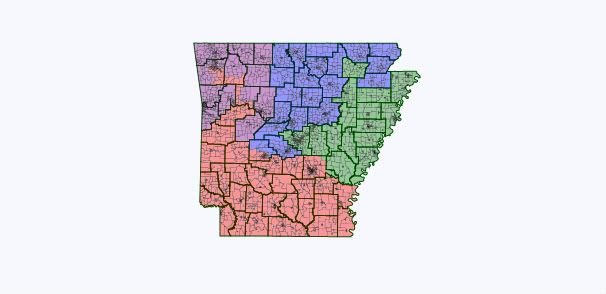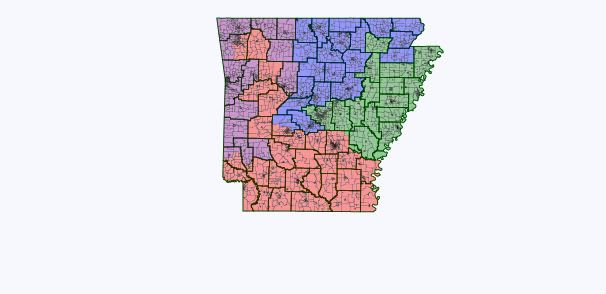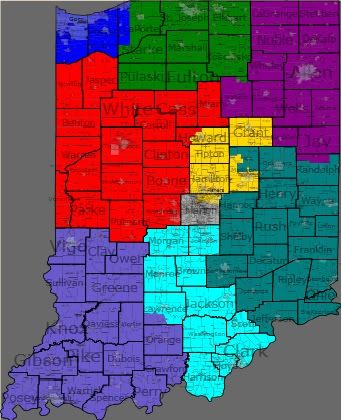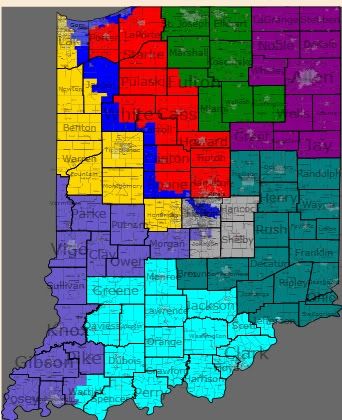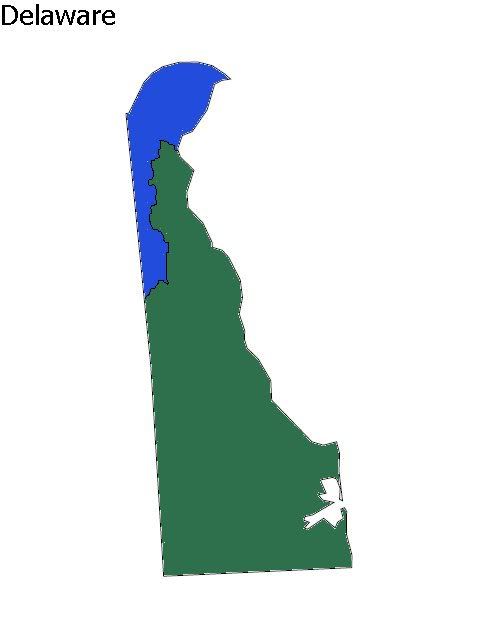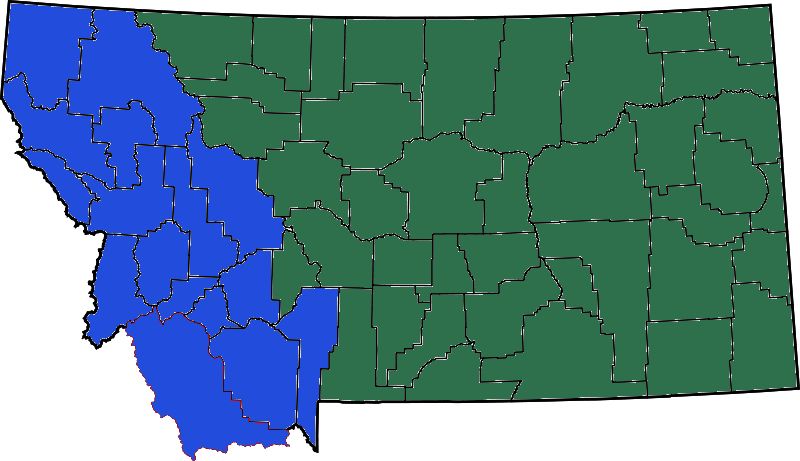EDIT: I thought I used the proper population estimate, but I didn’t, so I’ll have to do this over shortly.

CA-1 (BLUE): Mike Thompson
Includes all of Colusa, Glenn, Lake and Napa Counties, along with portions of Yolo and Sonoma Counties. This district is about 50% different than his old one, but he’s still more than safe, as his district now includes Santa Rosa, as well as Davis and Napa, all heavily Democratic places. Probably about 60-65% Obama, maybe more.
CA-2 (GREEN): Tom McClintock
Includes Lassen, Modoc, Sierra, Siskiyou, Tehama, Trinity, Yuba and portions of Placer and Sacramento Counties. McClintock takes in much of rural California, because my goal was to consolidate most of those areas into one district (communities of interest). I would imagine this district would be around the same percentage that it was in 2008, 55% McCain.
CA-3 (Purple): Dan Lungren
Includes Amador, Calaveras, El Dorado, Mariposa, Nevada, Tuolumne and portions of Madera, Placer and Sacramento Counties. This district is very different that his former one, as it includes more rural territory and less of suburban Sacramento. I would say it around 55-56% McCain.
CA-4 (RED): Wally Herger
Includes Butte, Plumas, Sutter and Shasta Counties and portions of Sacramento County. This includes Herger’s base of Redding and his hometown of Chico. My goal was to consolidate the more populated parts of counties in these parts together. Estimated 56-57% McCain.
CA-5 (YELLOW GOLD): Doris Matsui
Contained in Sacramento County. Doris Matsui will be fine here, this district remains that same and would be around 68-70% Obama.
CA-6 (TEAL): Lynn Woolsey
Includes Del Norte, Marin and Mendocino Counties, along with portions of Sonoma. The North Coast should be in one district and that’s exactly what I did. Woolsey will not having any problems here, the district will still be 70% plus for Obama.

CA-7 (GRAY): George Miller
Contained within Contra Costa. My goal here was to clean up Contra Costa, give it more consolidation between districts. George Miller keeps Richmond, but add other interior areas, like Walnut Creek. Again, another Democratic incumbent with modifications, but still perfectly safe. 65-70% Obama.
CA-8 (VIOLET): Nancy Pelosi
Contained within San Francisco County. Not much change here, except the district covers more of San Francisco. 80-85% Obama.
CA-9 (LIGHT BLUE): Barbara Lee
Contained within Alameda County. This district is slightly different, as it includes Alameda and San Leandro in addition to Oakland and Berkeley. 80-90% Obama.
CA-10 (PINK): John Garamendi
Contains Solano County and portions of Yolo and Sacramento Counties. This is one of the biggest modifications I made. Garamendi’s district no longer sprawls and is now neat. My best estimate on this one would be 60% Obama, close to a good bellwether for the state.
CA-11 (LIGHT GREEN): Jerry McNerney
Contains portions of Alameda, Contra Costa and Santa Clara Counties. McNerney keeps all of the Alameda portion of his old district and most of the Contra Costa and Santa Clara parts, while shedding the San Joaquin portions. He picks up Hayward. I felt that this looked very compact compared to the old one. 65-66% Obama.
CA-12 (SKY BLUE): Jackie Speier
Contains portions of San Mateo County and a portion of San Franscisco. The biggest difference here is that Speier has more of San Mateo County, making for a much more compact district. 70%+ Obama.
CA-13 (SALMON): Mike Honda or Pete Stark
Portions of Alameda and Santa Clara Counties. Alameda County didn’t grow much since last census, so it was very difficult to retain CA-13. Pete Stark and Mike Honda would likely face off in a primary here, unless Stark opted for retirement. Either way, still a safe Democratic district, 70%+ Obama.
CA-14 (CAMOUFLAGE): Anna Eshoo
Portions of San Clara and Santa Mateo Counties. This district shrinks and is confined neatly within the Silicon Valley. 70%+ Obama.
CA-15 (ORANGE): OPEN
Portions of Contra Costa and San Joaquin counties. Stockton is finally contained within one district and the district overall is very compact. I’m not sure who would run here, but the district would be winnable for the right Democrat. 60% Obama, a pretty good bellwether.
CA-16 (BRIGHT GREEN): Zoe Lofgren
Contained within Santa Clara County. A nice compact district that takes in San Jose and some adjacent communities. 69-70% Obama.
CA-17 (PURPLE): Sam Farr
Includes San Benito and Santa Cruz Counties, along with portions Monterey County. This district in a compact form is slightly more Democratic than the old one. 70+ Obama.
CA-18 (YELLOW) : Dennis Cardoza or Jeff Denham
Includes portions of San Joaquin County and all of Stanislaus. Cardoza’s hometown is Atwater in Merced County, which I moved to CA-20, but CA-18 holds lots of his old territory. This district was only 51% Obama and it would be a swing one which he would likely face incoming GOP Rep. Jeff Denham in, since Denham’s old district was dismantled. Cardoza may opt to run in the new CA-15, which would be has more of a Democratic tilt or he could run in CA-20, if Jim Costa doesn’t maintain his seat or if he does, run against him in the primary.

CA-19 (LIME GREEN): OPEN
Portions of Kern, Monterey and Santa Barbara Counties, with all of San Luis Obispo and Kings Counties. This district would about 51% McCain and 40% Hispanic, which would be a perfect fit for Abel Maldonado, who just lost the Lt. Gov’s race. North Santa Barbara County is hugely dysfunctional with South Santa Barbara County, so they’d be thrilled to have separate representation in Congress.
CA-20 (LIGHT PINK): Jim Costa or Andy Vidak
Portions of Fresno County and all of Merced County. Depending on how that race is decided, Costa would have a reasonbly safe district or Vidak would have one that wasn’t very favorable. I could have put Fresno in one district, but it would have been difficult to bring the sparsely populated places together in a compact way. About 58-60% Obama.
CA-21 (DARK RED): Devin Nunes
Portions of Fresno and Tulare Counties, plus Alpine, Mono and Inyo Counties. Not a drastic change, just sheds Visalia to CA-22 and picks up more of Fresno. Still about 56-57% McCain.
CA-22 (BROWN): Kevin McCarthy
Portions of Kern and Tulare Counties: Takes in most of Bakersfield and goes into Tulare and Visalia About 60% McCain.
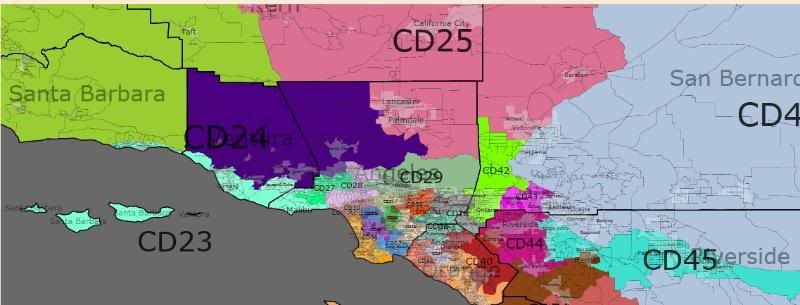
CA-23 (AQUA): Lois Capps
Portions of Los Angeles, Santa Barbara and Ventura Counties. I tried to make this district mainly coastal, while remaining compact and significantly smaller than the old one. The coastal cities have much of the same environmental and economic interests, while Thousand Oaks just ended up in there to balance out population. Probably about 60% Obama.
CA-24 (DARK PURPLE): Elton Gallegly
Portions of Los Angeles and Ventura Counties. I was worked very hard to make this one compact and put together places that made sense. Some parts of the San Fernando Valley are included. Probably about 50% or so McCain, maybe a little more or less.
CA-25 (MAGENTA): Buck McKeon
Portions of Kern, Los Angeles and San Bernardino Counties. I wanted to create a High Desert district that consolidated the fast growing communities in these counties. I had bit of a hard time doing that, but I managed to pull it off. Probably around 54-55% McCain.
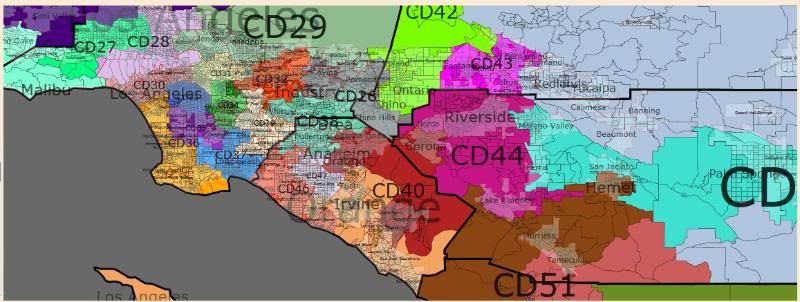
CA-26 (DARK GRAY): David Dreier
Portions of Los Angeles and San Bernardino Counties. This district is now quite different that it was before, including only a few areas from the old one and picking up Democratic voting Pomona. This part of Los Angeles County was very gerrymandered and this is how I best came up with how to undo it. 56% Obama.
CA-27: Brad Sherman
Portions of Los Angeles County. It pretty much stays the same, except for shedding some territory to CA-24 and not going into Burbank. 65%+ Obama.
CA-28: Howard Berman
Portions of Los Angeles County. Another one that is almost the same, it wasn’t difficult to make it compact without huge changes. 70%+ Obama.
CA-29: Adam Schiff
Portions of Los Angeles County. I included the entire city of Burbank in the district, as opposed to just half as in the previous map, along with some places from the old CA-26. Still probably 65%+ Obama.
CA-30: Henry Waxman
Portions of Los Angeles County. This one sheds parts of the San Fernando Valley and takes in more of Los Angeles. It looks much better and more compact than before. 70%+ Obama.
CA-31: Xavier Becerra
Portions of Los Angeles County. This district remains almost entirely within Los Angeles city limits and is still very Hispanic. Well over 70% Obama.
CA-32: Judy Chu
Portions of Los Angeles County. It shrinks some in size, but keeps much of the same territory. 60%+ Obama.
CA-33: Karen Bass
Portions of Los Angeles County. Now contained mostly within Los Angeles city limits, with most of the same territory. 80% Obama.
CA-34: Lucille Roybal-Allard
Portions of Los Angeles County. East Los Angeles and outlying communities, very Hispanic. Probably well over 75% Obama.
CA-35: Maxine Waters
Portions of Los Angeles County. Compton, Gardena, Hawthorne, Inglewood and some parts of Los Angeles. 80%+ Obama.
CA-36: Jane Harman
Portions of Los Angeles County. This district is about the same, except it consolidates the South Bay and Palos Verdes Peninsula. 60%+ Obama.
CA-37: Laura Richadson
Portions of Los Angeles County. This Long Beach dominated district doesn’t change much, except for removing Compton and adding some other communities in it’s place. Still 75%+ Obama.
CA-38: OPEN
Portions of Los Angeles and Orange Counties. This district was one of the most egregious gerrymanders. I broke up lots of territory and shifted other places. I formed the new CA-38 from Brea, Buena Park, Diamond Bar and Fullerton, along with some portions of Anaheim. Seeing as current 38th district holder, Grace Napolitano, is from Norwalk, which is in the 39th district now, and that this new 38th is an even PVI, she might attempt to primary Linda Sanchez or, shift to CA-26, which now includes the anchor of the old CA-38, Pomona. Republicans Ed Royce and Gary Miller’s hometowns are both in this district, so they could obviously run here, but might face stiff competition from a competent Democrat. They may opt to run in the new CA-40, which is heavily GOP. Overall, the district would be about 53% Obama.
CA-39: Linda Sanchez
Portions of Los Angeles County. Another gerrymander that I opted to undo. This one is now a proper Gateway Cities district and looks more sensible. Probably still well over 60% Obama.
CA-40: OPEN
Portions of Orange and Riverside Counties. This was almost a leftover’s district, but I didn’t compact it well. It takes in strongly Republican Orange and Yorba Linda, along with Corona. I think all these areas would have a reasonably similar median income, so the pairings make sense. Ed Royce, Gary Miller and Ken Calvert would likely face off here in the primary. 56% McCain.
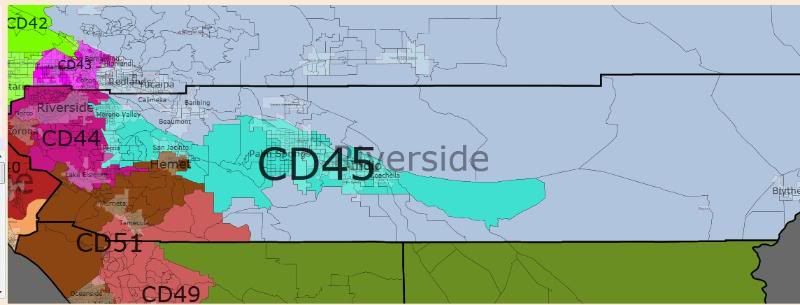
CA-41: Jerry Lewis
Portions of Riverside and San Bernardino Counties. It basically keeps it’s population centers, but wraps around and picks up more lightly populated parts of Riverside County. 56% McCain.
CA-42: OPEN
Portions of Los Angeles and San Bernardino Counties. I had couldn’t get the population just right with this one, but by my estimation, it would be right on the mark or close with these lines under the new census numbers as there has been lots of growth around these parts. This district is 49% Hispanic. It pairs Democratic voting Ontario with Republican Rancho Cucamonga and Chino. About 52-53% Obama.
CA-43: Joe Baca
Portions of San Bernardino County. More or less the same as it was before, but with big population growth, it would shift some of it’s territory to CA-42 and even out it’s population. Still would be 60%+ Obama.
CA-44: Ken Calvert
Portions of Riverside County. The City of Riverside, plus Norco and Lake Elsinore forms the new CA-44. Ken Calvert could try his luck here, but without Corona and the parts of Orange County from his old district, he’d likely lose to Bill Hedrick. It’d be easier for him to try his luck in the CA-40 primary, where he may have an edge with his hometown of Corona.
CA-45: Mary Bono Mack
Portions of Riverside County. This one shrinks down, confined strictly to a few communities. I combined Indio, Moreno Valley and Palm Springs for the population anchor, with smaller places like Perris and Coachella. Without Hemet and Murrieta, Bono Mack would be at a disadvantage. She could try her luck in CA-41 against ethically challenged Jerry Lewis. Steve Pougnet would be able to win this incarnation of CA-45, as it’s about 56% Obama.
CA-46: Dana Rohrabacher
Portions of Los Angeles and Orange Counties. Combines Huntington Beach and Newport Beach, along with other communities in that corner of Orange County. I estimate it’s about 55% McCain.
CA-47: Loretta Sanchez
Portions of Orange County. I made it slightly more compact, by adding more of Garden Grove. It’s about the same as before, although a bit less Obama than before, around 59% now.
CA-48: John Campbell
Portions of Orange County. Costa Mesa gets added to this district, as well San Clemente. About 50% Obama now. Might be promising for a Democrat in the future.

CA-49: OPEN
Portions of San Diego and Riverside Counties. Although Issa is from Vista, much of his old district is here. It’s very Republican (55% or more McCain) and he would have no problems, but he’d probably run in CA-51.
CA-50: Susan Davis
Portions of San Diego County. There was a lot of gerrymandering in these parts too, so I undid it and now Davis takes in about half of her old territory and a lot from CA-50. It’s a few points less Obama than her old district (probably about 63%), but she shouldn’t have any problems here.
CA-51: Brian Bilbray or Darrell Issa
Portions of Riverside and San Diego Counties. Bilbray and Issa may face off here, or one may opt for the new CA-49. Around 55-56% McCain, maybe more.
CA-52: Duncan Hunter Jr.
The whole of Imperial County and portions of San Diego County. My push for compactness made this one less Republican than it originally was, which wasn’t my intention. I wanted to make the lines that split San Diego looks more even and stick Imperial County in neatly, which resulted in a district that voted very narrowly for Obama. It would still have Republican lean, but be a lot more swingy.
CA-53: Bob Filner
Portions of San Diego County. Sheds Imperial County and picks up more of San Diego and Imperial Beach. Likely still around 60% or so Obama. Filner would be fine here.


